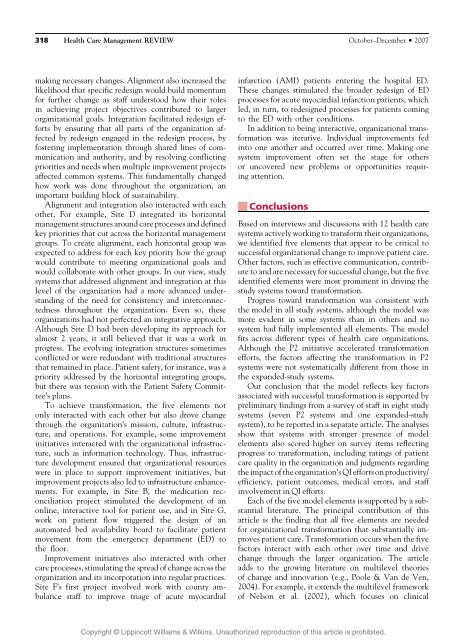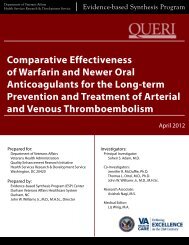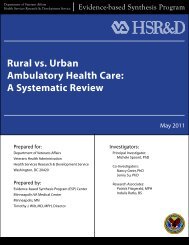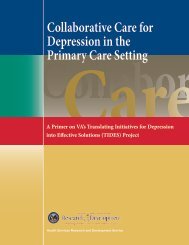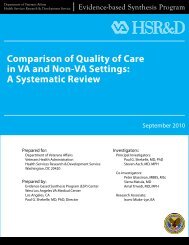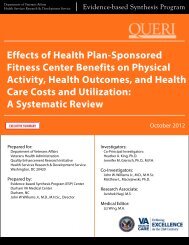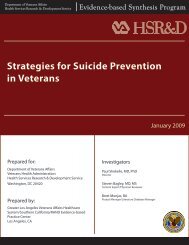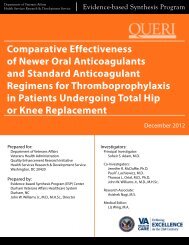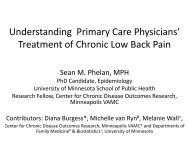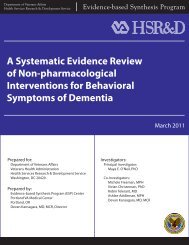VHA Systems Redesign; Transformational change in health care ...
VHA Systems Redesign; Transformational change in health care ...
VHA Systems Redesign; Transformational change in health care ...
Create successful ePaper yourself
Turn your PDF publications into a flip-book with our unique Google optimized e-Paper software.
318 Health Care Management REVIEW<br />
October–December 2007<br />
mak<strong>in</strong>g necessary <strong>change</strong>s. Alignment also <strong>in</strong>creased the<br />
likelihood that specific redesign would build momentum<br />
for further <strong>change</strong> as staff understood how their roles<br />
<strong>in</strong> achiev<strong>in</strong>g project objectives contributed to larger<br />
organizational goals. Integration facilitated redesign efforts<br />
by ensur<strong>in</strong>g that all parts of the organization affected<br />
by redesign engaged <strong>in</strong> the redesign process, by<br />
foster<strong>in</strong>g implementation through shared l<strong>in</strong>es of communication<br />
and authority, and by resolv<strong>in</strong>g conflict<strong>in</strong>g<br />
priorities and needs when multiple improvement projects<br />
affected common systems. This fundamentally <strong>change</strong>d<br />
how work was done throughout the organization, an<br />
important build<strong>in</strong>g block of susta<strong>in</strong>ability.<br />
Alignment and <strong>in</strong>tegration also <strong>in</strong>teracted with each<br />
other. For example, Site D <strong>in</strong>tegrated its horizontal<br />
management structures around <strong>care</strong> processes and def<strong>in</strong>ed<br />
key priorities that cut across the horizontal management<br />
groups. To create alignment, each horizontal group was<br />
expected to address for each key priority how the group<br />
would contribute to meet<strong>in</strong>g organizational goals and<br />
would collaborate with other groups. In our view, study<br />
systems that addressed alignment and <strong>in</strong>tegration at this<br />
level of the organization had a more advanced understand<strong>in</strong>g<br />
of the need for consistency and <strong>in</strong>terconnectedness<br />
throughout the organization. Even so, these<br />
organizations had not perfected an <strong>in</strong>tegrative approach.<br />
Although Site D had been develop<strong>in</strong>g its approach for<br />
almost 2 years, it still believed that it was a work <strong>in</strong><br />
progress. The evolv<strong>in</strong>g <strong>in</strong>tegration structures sometimes<br />
conflicted or were redundant with traditional structures<br />
that rema<strong>in</strong>ed <strong>in</strong> place. Patient safety, for <strong>in</strong>stance, was a<br />
priority addressed by the horizontal <strong>in</strong>tegrat<strong>in</strong>g groups,<br />
but there was tension with the Patient Safety Committee’s<br />
plans.<br />
To achieve transformation, the five elements not<br />
only <strong>in</strong>teracted with each other but also drove <strong>change</strong><br />
through the organization’s mission, culture, <strong>in</strong>frastructure,<br />
and operations. For example, some improvement<br />
<strong>in</strong>itiatives <strong>in</strong>teracted with the organizational <strong>in</strong>frastructure,<br />
such as <strong>in</strong>formation technology. Thus, <strong>in</strong>frastructure<br />
development ensured that organizational resources<br />
were <strong>in</strong> place to support improvement <strong>in</strong>itiatives, but<br />
improvement projects also led to <strong>in</strong>frastructure enhancements.<br />
For example, <strong>in</strong> Site B, the medication reconciliation<br />
project stimulated the development of an<br />
onl<strong>in</strong>e, <strong>in</strong>teractive tool for patient use, and <strong>in</strong> Site G,<br />
work on patient flow triggered the design of an<br />
automated bed availability board to facilitate patient<br />
movement from the emergency department (ED) to<br />
the floor.<br />
Improvement <strong>in</strong>itiatives also <strong>in</strong>teracted with other<br />
<strong>care</strong> processes, stimulat<strong>in</strong>g the spread of <strong>change</strong> across the<br />
organization and its <strong>in</strong>corporation <strong>in</strong>to regular practices.<br />
Site F’s first project <strong>in</strong>volved work with county ambulance<br />
staff to improve triage of acute myocardial<br />
<strong>in</strong>farction (AMI) patients enter<strong>in</strong>g the hospital ED.<br />
These <strong>change</strong>s stimulated the broader redesign of ED<br />
processes for acute myocardial <strong>in</strong>farction patients, which<br />
led, <strong>in</strong> turn, to redesigned processes for patients com<strong>in</strong>g<br />
to the ED with other conditions.<br />
In addition to be<strong>in</strong>g <strong>in</strong>teractive, organizational transformation<br />
was iterative. Individual improvements fed<br />
<strong>in</strong>to one another and occurred over time. Mak<strong>in</strong>g one<br />
system improvement often set the stage for others<br />
or uncovered new problems or opportunities requir<strong>in</strong>g<br />
attention.<br />
Conclusions<br />
Based on <strong>in</strong>terviews and discussions with 12 <strong>health</strong> <strong>care</strong><br />
systems actively work<strong>in</strong>g to transform their organizations,<br />
we identified five elements that appear to be critical to<br />
successful organizational <strong>change</strong> to improve patient <strong>care</strong>.<br />
Other factors, such as effective communication, contribute<br />
to and are necessary for successful <strong>change</strong>, but the five<br />
identified elements were most prom<strong>in</strong>ent <strong>in</strong> driv<strong>in</strong>g the<br />
study systems toward transformation.<br />
Progress toward transformation was consistent with<br />
the model <strong>in</strong> all study systems, although the model was<br />
more evident <strong>in</strong> some systems than <strong>in</strong> others and no<br />
system had fully implemented all elements. The model<br />
fits across different types of <strong>health</strong> <strong>care</strong> organizations.<br />
Although the P2 <strong>in</strong>itiative accelerated transformation<br />
efforts, the factors affect<strong>in</strong>g the transformation <strong>in</strong> P2<br />
systems were not systematically different from those <strong>in</strong><br />
the expanded-study systems.<br />
Our conclusion that the model reflects key factors<br />
associated with successful transformation is supported by<br />
prelim<strong>in</strong>ary f<strong>in</strong>d<strong>in</strong>gs from a survey of staff <strong>in</strong> eight study<br />
systems (seven P2 systems and one expanded-study<br />
system), to be reported <strong>in</strong> a separate article. The analyses<br />
show that systems with stronger presence of model<br />
elements also scored higher on survey items reflect<strong>in</strong>g<br />
progress to transformation, <strong>in</strong>clud<strong>in</strong>g rat<strong>in</strong>gs of patient<br />
<strong>care</strong> quality <strong>in</strong> the organization and judgments regard<strong>in</strong>g<br />
the impact of the organization’s QI efforts on productivity/<br />
efficiency, patient outcomes, medical errors, and staff<br />
<strong>in</strong>volvement <strong>in</strong> QI efforts.<br />
Each of the five model elements is supported by a substantial<br />
literature. The pr<strong>in</strong>cipal contribution of this<br />
article is the f<strong>in</strong>d<strong>in</strong>g that all five elements are needed<br />
for organizational transformation that substantially improves<br />
patient <strong>care</strong>. Transformation occurs when the five<br />
factors <strong>in</strong>teract with each other over time and drive<br />
<strong>change</strong> through the larger organization. The article<br />
adds to the grow<strong>in</strong>g literature on multilevel theories<br />
of <strong>change</strong> and <strong>in</strong>novation (e.g., Poole & Van de Ven,<br />
2004). For example, it extends the multilevel framework<br />
of Nelson et al. (2002), which focuses on cl<strong>in</strong>ical<br />
Copyright @ Lipp<strong>in</strong>cott Williams & Wilk<strong>in</strong>s. Unauthorized reproduction of this article is prohibited.


